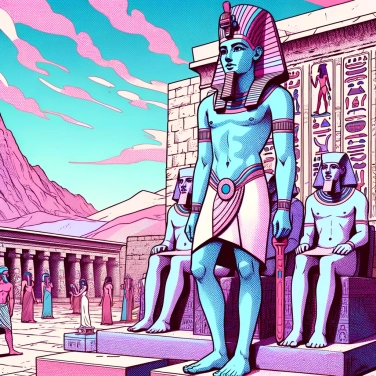Hatshepsut was portrayed as a man in statues to reinforce her image as a pharaoh and to establish her authority in a society where power was traditionally associated with masculinity.

In ancient Egypt, religion played a crucial role in society—impossible to miss it. The Egyptians believed that the pharaoh embodied a earthly form of gods like Horus or Osiris. This idea made the king a sacred figure with a central role that was both religious and political. Traditionally, royalty was associated with specific masculine attributes, symbolizing power, authority, and stability; in short, at that time, ruling sounded rather manly. Artistic conventions reflected this deeply rooted cultural model: representing the sovereign with pronounced musculature, a ceremonial beard (even if artificial), and other virile symbols ensured the immediate recognition of his supreme authority by everyone—both the population and the clergy.
In ancient Egypt, the royal role was traditionally perceived as exclusively masculine, symbolized by certain specific attributes: false beard, short kilt, or the traditional crown typically reserved for men. In short, everything clearly indicated that being pharaoh was a man's business. However, Hatshepsut, one of the few women to fully assume the title of pharaoh, chose to adopt these masculine attributes to symbolically reinforce her authority. By being depicted with a masculine silhouette, she visually asserted her legitimacy as the supreme ruler despite her unusual status as a woman. This shift to a masculine image allowed Hatshepsut to clearly align herself with the continuity of Egyptian monarchical traditions, where a masculine appearance was synonymous with strength, authority, and above all, stability of power.
Hatshepsut chose to adopt a masculine appearance to signify a certain political authority. In her time, power was typically embodied by a man; a female pharaoh was not easily accepted. Representing herself as a man thus helped to assert her legitimacy before the people, the nobles, and the priests. She also sought to avoid internal conflicts and to prevent any criticism of her ability to lead Egypt. In short, projecting a masculine image allowed her to consolidate her reign, ensure better political stability, and facilitate popular acceptance.
In ancient Egyptian tradition, the pharaoh is the living embodiment of the god Horus on Earth. This divine role was symbolized by certain typically masculine traits, such as the false beard or the short kilt. To be recognized as a legitimate ruler, Hatshepsut had to adopt this traditional masculine image, directly associated with the gods and the pharaohs before her. Adhering to these codes was crucial for maintaining the cosmic order, known as Maât, which ensured prosperity and harmony in the kingdom. Hatshepsut knew that breaking this tradition risked questioning her divine authority in the eyes of the people and the priests. Thus, she did not hesitate to wear a false beard, crowns, and typically masculine clothing to strengthen her bond with the gods and ensure her legitimacy on the throne.
In ancient Egypt, depicting the pharaoh in a masculine form was a traditional way to ensure political and divine continuity, deeply rooted in the religious thought of the time.
Modern research has identified the mummy of Hatshepsut through a tooth belonging to a coffin marked with her name, thus providing concrete insights into her story, which has long remained mysterious.
The statues representing Hatshepsut with a ceremonial beard were intended to symbolize royal power and her legitimacy to rule, rather than a personal desire to change gender.
Although depicted in a masculine appearance, Hatshepsut used feminine titles in official texts, such as 'daughter of the god Ra,' thereby clearly affirming her female identity.
No. Hatshepsut was a female pharaoh who chose to represent her image in a masculine way to meet the cultural and religious expectations of the time, thereby reinforcing her authority and status as a monarch in a predominantly patriarchal society.
His direct successor, Thutmose III, attempted to erase the memory of her reign by destroying or hiding her statues and inscriptions, likely with the aim of restoring the traditional male dynastic order at the head of the kingdom of Egypt.
Yes, several women have temporarily taken power or exerted strong political influence. Notable examples include Sobekneferou and Cleopatra VII. However, Hatshepsut remains one of the most influential and historically recognized female rulers.
Modern historians regard Hatshepsut as an exceptional leader, notable for her administrative talent, ambitious architectural projects, and her subtle strategy of adopting masculine iconography to strengthen her position. She is now studied as a pioneering example of female power.
The false beard symbolized divine power and royal authority according to ancient Egyptian tradition. By adopting it, Hatshepsut clearly asserted her legitimacy as a sovereign equal to the previous male kings.

No one has answered this quiz yet, be the first!' :-)
Question 1/6